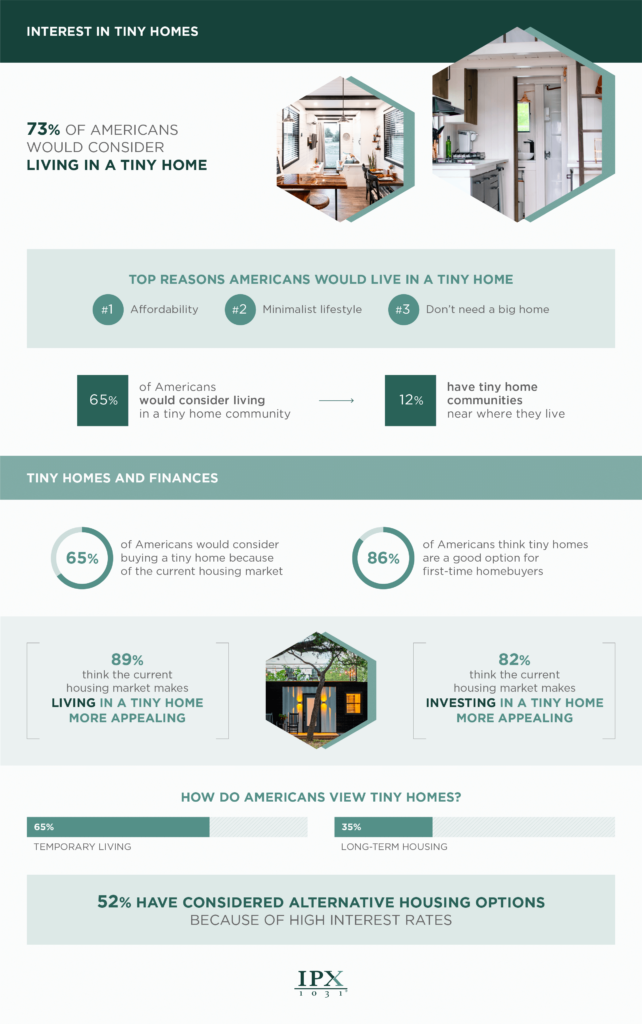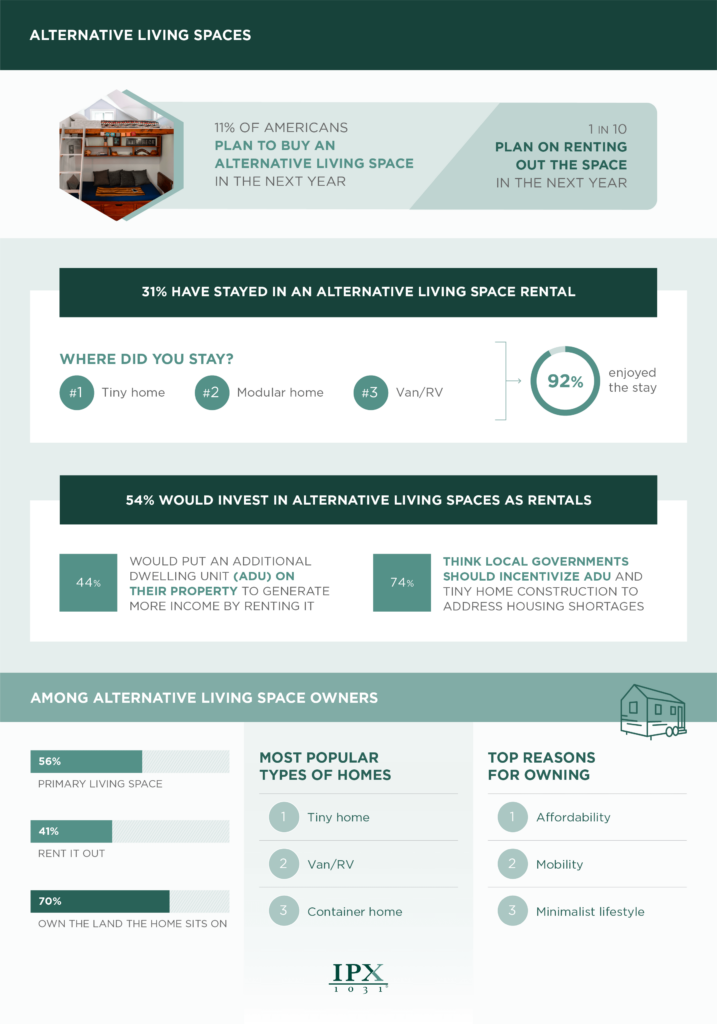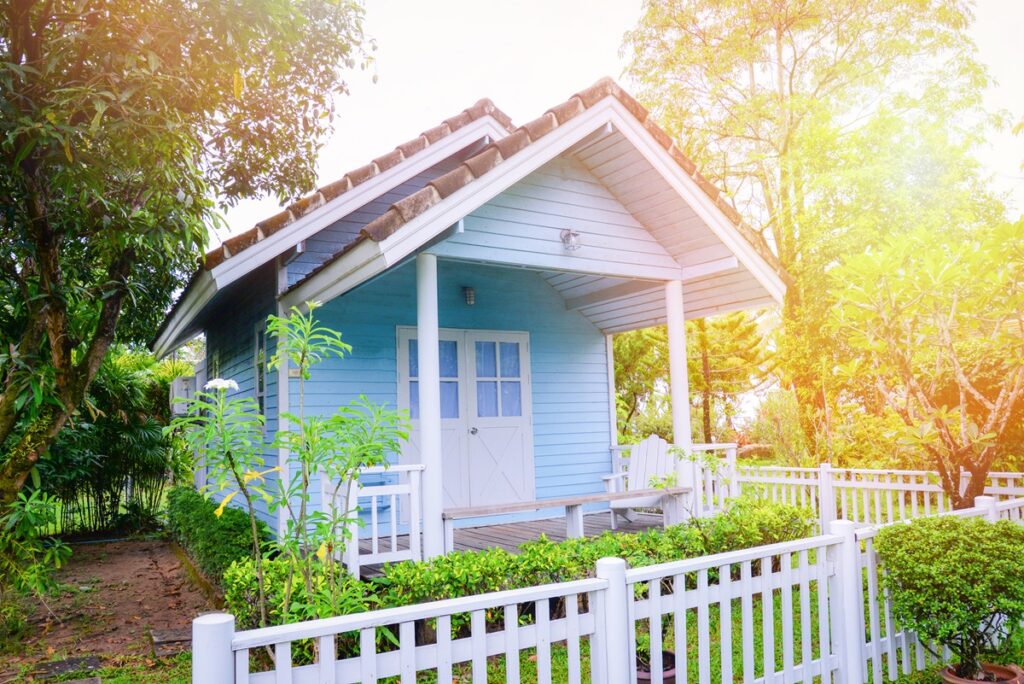As high interest rates and limited inventory continue to impact the housing market, many Americans may feel attaining homeownership is no longer within reach.
However, a new study conducted by IPX1031 found that 73% of Americans would opt to live in a tiny home, a more compact and budget-friendly option that measures under a maximum of 500-square-feet. Among the generations, Gen Z and Millennials were found the most interested in living in tiny homes, as 75% of those polled considered living in one.
In February 2024, 1,010 people from around the U.S. were surveyed by IPX1031, and among respondents, 49% identified as male and 49% as female ranging in age from 18-84 with an average age of 41.

The weight of factors
Among those polled, the top three reasons cited for living in a tiny home were:
- Affordability
- Minimalist lifestyle
- Did not need a big home
Also playing a key role in the choice for a tiny home was finances, as 65% of Americans would consider buying a tiny home because of the current housing market, and 86% felt tiny homes were a good option for first-time buyers.
Affordability remains an issue for many as just last week, Freddie Mac reported that the 30-year fixed-rate mortgage (FRM) averaged 6.87% as of March 21, 2024, up from the previous week when it averaged 6.74%. A year ago at this time, the 30-year FRM averaged 6.42%.
And as rates continue to edge toward the 7%-mark, mortgage application volume decreased 1.6% week-over-week, according to data from the Mortgage Bankers Association’s (MBA) Weekly Mortgage Applications Survey for the week ending March 15, 2024.
IPX1031 reported that 89% of those polled found tiny homes more appealing as living options, and 82% viewed them as attractive investments. More than half of those polled (52%) considered alternative housing options (tiny homes, container homes, van life, etc.) because of high interest rates.
Ranking tiny homes by region
IPX1031 found that individuals living in the following states were found to be the most interested in living in tiny homes:
- Vermont
- Wyoming
- Alaska
- Maine
- Montana
- North Dakota
- South Dakota
- New Hampshire
- Arkansas
- Tennessee
According to Zillow, the average U.S. home value is $347,716, up 3.6% over the past year, while the average Vermont home value currently stands at $373,001, up 5% over the past year. The average Wyoming home value is $334,782, up 3.2% over the past year, while the average Alaska home value is $349,502, up 1.1% over the past year.
To rank the states and cities, IPX1031 analyzed more than 1,300 Google search terms relating to tiny homes over the last two years. They then took the average number of monthly searches for each state and calculated the searches per 100,000 residents.
Tiny homes as alternative living spaces
Interest in alternative living spaces is growing among Americans. Alternative living spaces are housing structures that are built or designed outside of the mainstream norm, such as tiny homes, container homes, modular homes, or converted vans.
Slightly more than one in 10 Americans plan to buy an alternative living space in the next year, and among them, 10% plan to rent the space out. Nearly one in three Americans have stayed in an alternative living space rental, and 92% enjoyed the stay. The most common types of rentals included tiny homes, modular homes, and vans/RVs.

Fifty-four percent of those polled would consider investing in alternative living spaces as rentals. Additionally, statistics show 44% would consider putting an additional dwelling unit (ADU) on their property to generate more income by renting it out and nearly 75% felt local governments should incentivize ADU and tiny home construction to address housing shortages.
The University of California, Los Angeles (UCLA) was recently awarded $458,340 by the U.S. Department of Housing & Urban Development (HUD) to study the impact of ADU legalization and production in California on rents and prices, as well as to assess how legalization changes land values even for parcels that do not exercise the new development option.
Click here for more on IPX1031’s study on tiny homes in America.





